Peanut, the squirrel-themed cryptocurrency, experienced a rapid surge earlier in the month, followed by a gradual decline over the past week. Traders are closely watching the critical price levels of $1.5 and $1, with the former already breached and now acting as a support level.
The overall sentiment in the cryptocurrency market was quite bullish, especially as Bitcoin approached the $100,000 mark. While Bitcoin is expected to continue its upward trajectory, Peanut’s price may face a period of consolidation with a potential retracement in the near future.
Peanut’s Price Dips to the 50% Retracement Level
Looking at the 4-hour chart, Peanut’s price momentum appeared to be weakening. The $1.5 support level, which had been defended by buyers since November 14th, finally gave in to selling pressure after a week-long battle with the bears.
Key support levels at $1.29, $1, and $0.6 were identified through Fibonacci retracement levels for potential buyers of Peanut token. The Relative Strength Index (RSI) on the 4-hour chart dropped below the neutral 50 level, indicating a shift in momentum favoring the bears.
As a result, a further decline towards $1 and potentially $0.6 could be on the horizon. The On-Balance Volume (OBV) supported this view by failing to sustain levels seen in the previous week, signaling increased selling activity and a higher likelihood of a retracement towards the $1 mark.
Temporary Bearish Trend in Speculative Markets
The declining trend in the spot Cumulative Volume Delta (CVD) over the last week suggested waning demand in the spot markets. This trend aligned with the OBV indicator, indicating a short-term bias in favor of sellers.
Moreover, the funding rate was on a downward trajectory, and the Open Interest decreased from $318 million to $261 million within four days, hinting at diminishing bullish sentiments in the market. This gradual erosion in Peanut’s price underscores the hesitance among speculators to take long positions, despite the ongoing bullish momentum in Bitcoin towards $100,000.
Disclaimer: The opinions expressed in this article are personal views and should not be considered as financial advice. Readers should conduct their research before making any investment decisions.

